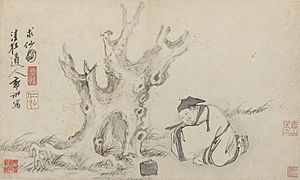Qiu Chuji facts for kids
Quick facts for kids Qiu Chuji |
|||||||||
|---|---|---|---|---|---|---|---|---|---|

Qiu Chuji as painted by Guo Xu, 1503
|
|||||||||
| Traditional Chinese | 丘處機 | ||||||||
| Simplified Chinese | 丘处机 | ||||||||
|
|||||||||
| Master Changchun | |||||||||
| Traditional Chinese | 長春子 | ||||||||
| Simplified Chinese | 长春子 | ||||||||
| Literal meaning | Master of the Eternal Spring | ||||||||
|
|||||||||
Qiu Chuji (born February 10, 1148 – died August 21, 1227) was a famous Taoist leader. He was also known by his Taoist name, Master Changchun. He was a student of Wang Chongyang, who founded the Quanzhen school of Taoism. Qiu Chuji was the most well-known among the "Seven True Taoists of the North." He started the Dragon Gate branch of Taoism, which became very popular.
Contents
Meeting Genghis Khan
Why Genghis Khan Invited Changchun
In 1219, the powerful leader Genghis Khan sent a letter to Master Changchun. He invited Changchun to visit him. Genghis Khan was interested in finding a "philosopher's stone" or a secret medicine for a long life.
Changchun's Long Journey
Changchun started his long journey in February 1220 from his home in Shandong, China. He first traveled to Beijing. Since Genghis Khan had moved west, Changchun spent the winter there.
In February 1221, he continued his trip. He traveled across eastern Mongolia and then southwest. He crossed the Karakorum region and reached the Altai Mountains. He visited a city called Bishbalig, which is now Ürümqi.
Changchun then traveled along the north side of the Tian Shan mountains. He passed by Lake Sutkol (now Sairam) and the city of Almaliq. He also went through the rich valley of the Ili.
From there, Changchun continued his journey through many lands. He passed through Balasagun, the Shu River, and Talas. He went to the Tashkent area and crossed the Syr Darya river to reach Samarkand. He stayed in Samarkand for several months.
Finally, he traveled through the Iron Gates of Termit. He crossed the Amu Darya river. After passing through Balkh and northern Afghanistan, Changchun reached Genghis Khan's camp. This camp was located near the Hindu Kush mountains.
Conversations with Genghis Khan
When they met, Changchun explained the ideas of Taoist philosophy. He talked about different ways to live a long life. He was honest and told Genghis Khan that there was no secret medicine for immortality.
They had 12 deep conversations about life and wisdom. Genghis Khan was very impressed by Changchun. He gave him the special title "Spirit Immortal." Genghis Khan also put Changchun in charge of all religious people in his large empire. Their talks were written down in a book called Travels to the West of Qiu Chang Chun.
Changchun's Return Journey
Changchun mostly followed the same path back home. He made a few detours, like visiting Hohhot. He arrived back in Beijing by the end of January 1224.
The book about his journey gives us amazing details. It describes the nature and people between the Great Wall of China and Kabul. It also covers the areas between the Aral and Yellow Seas.
The book has interesting descriptions of the Mongols and the people of Samarkand. It also talks about the land and products of Samarkand and the Ili Valley. It describes many large mountain ranges and passes, like the Chinese Altay and the Tian Shan.
After returning, Changchun lived in Beijing until his death on July 23, 1227. Genghis Khan ordered that some old imperial garden lands be given to him. This was for Changchun to build a Taoist temple. This temple is known as the Monastery of the White Clouds and still exists today.
Qiu Chuji in Stories
Qiu Chuji appears as a character in some famous stories.
- He is in Jin Yong's novels Legend of the Condor Heroes and Return of the Condor Heroes. He also appears in the 2013 movie An End to Killing. In these stories, he is shown as a strong-willed priest who often gets into fights. This is different from how he was in real life. His actions in the first story greatly influence the two main male characters.
- The Estonian writer Arvo Valton wrote a novel about Qiu Chuji's journey. It is called Journey to the Other Side of Infinity (Tee lõpmatuse teise otsa, 1978). It tells the story of his trip to meet Genghis Khan and their meetings.
See also
 In Spanish: Qiu Chuji para niños
In Spanish: Qiu Chuji para niños

